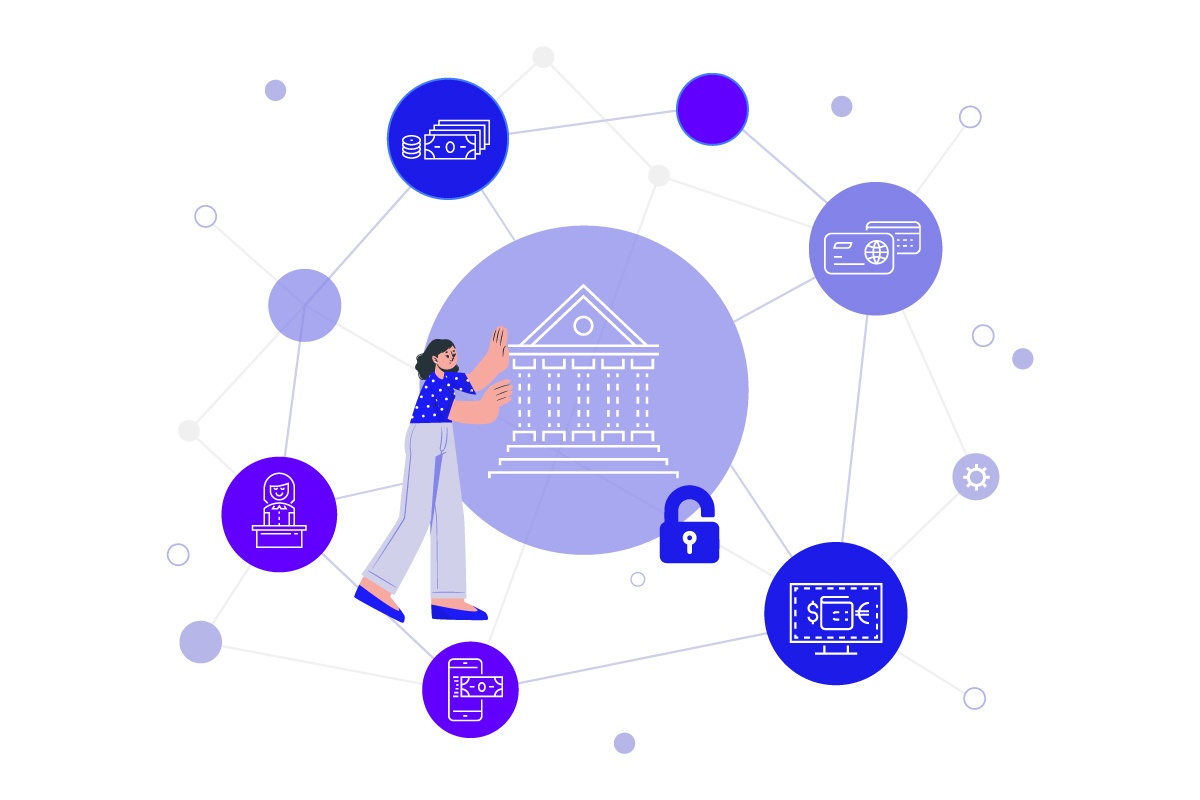5 Benefits of Open Banking APIs

Open banking APIs (application programming interfaces) offer a wide range of benefits for a modern financial institution, from increasing revenue to reducing fraud risk.
Open banking is finding its way into Canada with the government working hard to set regulations by the tentative launch date of January 2024.
In the meantime, financial institutions like yours should start preparing. When open banking is introduced to the public, you should be in a position to roll out products and services faster than competitors and with minimal friction.
Below, we explain the meaning of APIs, the state of open banking in Canada, and how exactly open banking APIs can help your business.
What is Open Banking?
Open banking refers to using APIs to access financial data by third parties in a secure manner.
Customers expect faster, one-stop banking services. So far, customers have relied on third-party services that use screen scraping for non-core banking services like budgeting and financial decision-making.
Screen scraping leaves your customers vulnerable to multiple types of online threats. In a world rampant with cybercrime, your customers want a safer alternative, and that’s where open banking offers value.
With open banking, you can securely allow third parties to access your financial data. For example, suppose a fintech app offers AI-based investment advice.
To offer advice, it needs to look at your current portfolio. You can use open banking to allow the app to access your financial data securely without having to use screen scraping.
This model offers all parties a benefit — you can use the app faster, the fintech can operate with the bank’s license, and the bank can charge a fee for the customer data.
Open Banking in Canada
Open banking is currently unavailable in Canada. The government is developing a roadmap to introduce open banking in Canada safely.
According to the Final Report from the Advisory Committee on Open Banking, the government has established four groups to provide input on the four fundamental aspects of the open banking framework—accreditation, liability, privacy, and security.
The original target date to introduce open banking was January 2023. However, the committee is yet to reach a consensus on multiple aspects.
The Canadian government may take a while to implement open banking. But we’ll likely see key developments in the implementation process over the next few months.
The government has appointed Abraham Tachjian to develop the open banking framework for Canada.
Benefits of Open Banking APIs
While you wait for open banking regulations to become available in Canada, it’s best to prepare your API ecosystem, so you’re ready for open banking when it’s introduced.
Once you have a mature open banking API ecosystem that’s operational, you’ll benefit in the following ways:
Increased Revenue
As a financial institution, you can use open banking APIs to increase revenue in one or more of the following ways:
- Partnering with Fintechs offering innovative solutions: You can partner with Fintechs to offer innovative solutions without creating, managing, or innovating products and services in-house. The partnership allows you to offer services your customers expect and improve their end-to-end journey. Of course, these services also create new revenue streams for you.
- Selling to Fintechs: As a bank, you can add another revenue source by providing banking-as-a-service (BaaS), where third parties can connect to your database using APIs for a fee. Third parties can use this data to provide value-add services in addition to what regulators mandate.
- Optimize your marketing campaigns based on user data: Open banking, combined with data aggregation, provides deeper insights into customers’ behavior and choices. These insights enable you to position your products better and run personalized marketing campaigns, which can increase your overall revenue.
Banking as a Service (BaaS)
Open banking APIs and Banking-as-a-Service are often used interchangeably.
However, they’re fundamentally different. BaaS is a business model where banks integrate their services into a third-party’s product or service.
Fintechs and non-financial companies (NFCs) use BaaS to offer customers better digital banking services, like one-minute loan approvals, without getting their own banking license. This is made possible through open banking APIs.
BaaS is quickly gaining popularity as customer dissatisfaction with banks’ existing services grow. According to Deloitte, 2x ROAA (return on average assets) for banks focused on BaaS offerings.
A few ways you can monetize by proving BaaS include:
- Providing your banking license, technology, and products to other banks, non-financial companies (NFCs), and aggregators.
- You can partner with a distributor with excellent end-user relationships to offer innovative financial solutions.
- You can partner with an aggregator who acts as a provider-aggregator to provide an out-of-the-box solution by coupling the capabilities of multiple vendors.
Payment as a Service (PaaS)
Open banking APIs allow you to build faster, more secure bank rails. Once you implement open banking, you can enable users to make direct payments seamlessly without entering card details.
As a bank, you can use open banking APIs to increase payments’ transparency and scalability by leveraging individual transactions and bi-directional processing.
With open banking APIs, you can upscale your current payment methods like ACH (Automatic Clearing House Network) and wire transfers. APIs will also enable you to offer modern payment methods like Real-Time Payments (RTPs) and Pay-By-Bank when they become available in Canada.
Open banking also facilitates payment initiation service (PIS). When a merchant partners with a licensed third party, the third party can initiate a payment on behalf of a customer’s bank account using PIS.
PIS doesn’t require the customer or merchant to share any sensitive information. The customer simply approves a payment via the banking app with a secret pin or biometric authentication.
Just like any account-to-account transfer, the money is transferred directly to the merchant’s account within seconds.
Improved Customer Engagement
Open banking APIs improve customer engagement by streamlining the onboarding process and offering a one-stop solution for multiple needs.
For example, open banking APIs can allow biometric logins and authentication to minimize the time it takes your customer to access the account. Your users will be able to complete tasks faster without compromising data security.
With Canadians worried more than ever about the cost of living crisis in Canada, they’re carefully observing their money.
Typically, they’d need to source information from individual sources to get a full picture of their financial status in order to make sound financial decisions.
Open banking APIs can simplify the process by allowing third-party apps to automatically aggregate this information into a single app, improving customer engagement.
Reduced Risk of Fraud
Open banking APIs provide access to customer data, allowing more accurate risk profiling. Access to customer data allows incorporating verified identity information, account balances, and transaction patterns into your risk models.
The UK, where open banking has been available since 2018, has reduced card fraud significantly. In 2021, the UK reduced the losses from card fraud by an impressive £49.2 million.
The following four things make open banking payments safer:
- Each payment uses strong customer authentication (SCA), which was introduced as a requirement in Europe by the revised Payment Services Directive 2 (PSD2) for ecommerce transactions in 2019.
- No sensitive information is required for any open banking use case.
- APIs pre-populate payment information.
- Open banking providers take care of onboarding the merchants as well as carrying out the necessary due diligence.
Read More: Open Banking in Canada: How Banks and Customers Can Benefit
Implementing Open Banking APIs with Blanc Labs
Familiarizing yourself with open banking APIs is critical to ensure you’re equipped with the right knowledge and tools when open banking becomes available in Canada.
The problem? It can feel daunting. Partnering with the right team can make the process a whole lot easier.
Blanc Labs, in partnership with Axway and Mulesoft, can help you build a robust open banking API ecosystem. We can answer any questions you have and take care of the end-to-end implementation process.
Book a discovery call with Blanc Labs to learn more about open banking APIs.
